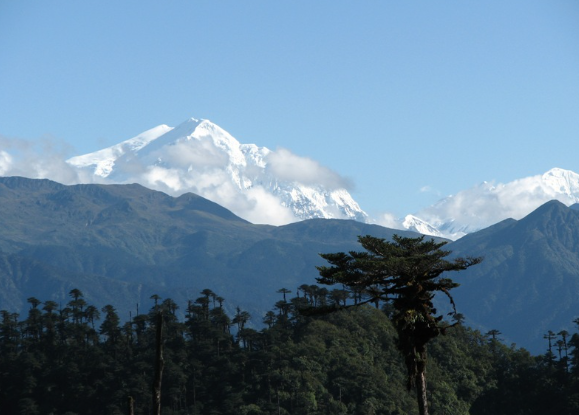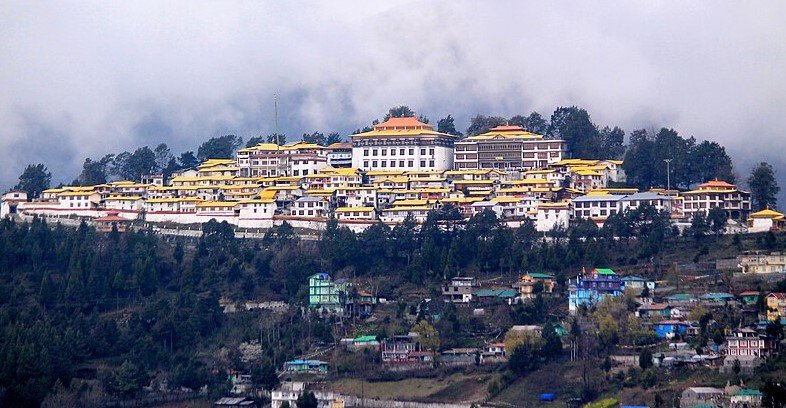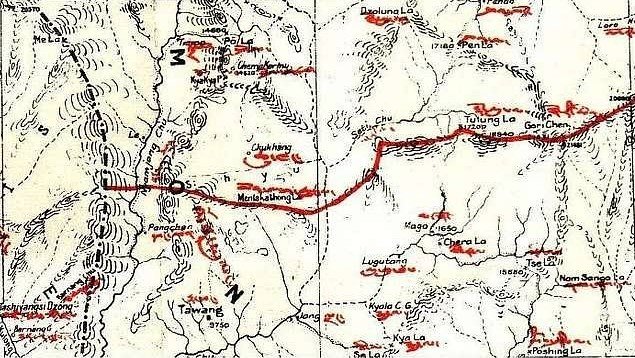Arunachal Pradesh is an exciting state to visit in the country’s northeastern part. People call this region the ‘Land of the Rising Sun.’ Well, it is for a reason! There is incredible beauty, culture, and history in this beautiful state. Not only will so many facts about Arunachal Pradesh fail to engage you, but you will learn more about this particular portion of India, between the towering Himalayan mountains and dense unmanned forests. So, let’s cut the chase and find out all the wonders of Arunachal Pradesh.
Quick Navigation
Geography and Climate
Arunachal Pradesh, situated in the northeasternmost part of India, shares its borders with Bhutan, China, and Myanmar, respectively. It is also the largest state in the Northeast region, with more than 83,743 sq km of area. The terrain is most dominantly characterized by the great Himalayan Mountains, with elevations beyond 23000 feet.
The internal geography of Arunachal Pradesh is composed of very high mountain peaks, high-altitude plates, and vast river basins. The state comprises three central physiographic regions: the foothills, the Lesser Himalayas, and the Great Himalayas. The foothills region in the south rises above the plains of Assam. In contrast, the Lesser Himalayan region rises to the north from the foothills, comprising some ridges and spurs above 10000 feet. Another interesting fact about Arunachal Pradesh is that Kangto is the highest peak in the state, which lies in the majestic Great Himalayan ranges, at 23260 feet above sea level.

Some prominent Indian rivers flowing in Arunachal Pradesh include the Brahmaputra and its tributaries, such as the Dibang, Lohit, Subansiri, Kameng, and Tirap rivers. These rivers descend the mountain slopes and form deep, very steep ravines within the mountain ranges, proving to be picturesque and rugged terrain.
The weather pattern of Arunachal Pradesh differs significantly in terms of altitude and geolocation. Conditions are hot and humid south of the foothills, with diagonal subtropical climbing, where summer temperatures may exceed the mid-90s.
Otherwise, winter conditions also have moderate temperatures. In the higher ozone layer, only mid-fifty highs may arise. Rainfall occurs in a monsoonal pattern, with significant precipitation between summer months, such as southwest monsoons, from April to September. This is more pronounced in the state’s central region, where rainfall may exceed over 160 inches annually.
Biodiversity
Arunachal Pradesh’s state can be called a pinnacle of biodiversity. Due to the wide variety of habitats, including tropical rainforests and alpine meadows, this state supports a wide range of flora and fauna.
One of the most surprising facts about Arunachal Pradesh is that about two-thirds of the state is covered by forests, with a broad band of swampy rainforests along the foothills. These forests change from tropical evergreen and subtropical pine forests at lower levels to temperate mixed and coniferous forests at higher elevations. The upper slopes are primarily covered with subalpine and alpine plants, with large and stunning rhododendrons being the species most noticeable.
The state is also famous for medicinal plants, such as ginseng and yew, which the natives have used for generations to cure various illnesses.
Animal life is one of the factors that has made Arunachal Pradesh a paradise. In this region, one can easily find striped cats, cloud and snow leopards, elephants, bison, and different kinds of deer. In the mountains, one may see the rarer musk deer and the unusual goat-antelope called takin. Primates, such as hoolock gibbons, slow lorises, macaques, and capped langurs, also inhabit the state.
The bird population is another feature contributing to such diverse animal life, with hundreds of species in the state. Bird watchers will appreciate the amount and types of birds one can encounter here, from the splendid Himalayan griffon vulture to the beautiful Mandarin duck.

Cultural Diversity
Arunachal Pradesh facts tell us that it is a state that may be the most culturally diverse in the Incredible India. More than 25 major tribes and many sub-tribes exist in the state. Each has its language and way of life, creating a picture of a pleasing and exciting set of people.
Some of the prominent tribes in Arunachal Pradesh include Adi, Apatini, Nyshi, Galo, Tagin, Lisu, Monpa, Sherdukpen, Tawang Monpa, Khamba, Memba, Meyor, Mishmi, Idu Mishmi, Aka, Hruso, Bugun, Khowa, Digaru Mishmi, Hill Miri, Bori, Puroik, Sartang, Taraon and Tangsa. All of these tribes have their languages, and many of them are entirely unrelated to each other.
The cultural traditions of Arunachal Pradesh are no less geographical and exciting. The state’s handicrafts are genuinely spellbinding, ranging from the elaborate handlooms, textiles and weaving techniques of the Apatani to the beautiful hand-carved wooden masks and wall hangings of the Nyishi people.
Also, many of the tribal groups in Arunachal Pradesh have their festivals and observances related to specific times of the year, mostly connected with the agricultural cycle or essential events from the tribe or community’s history. There is the case, for instance, within the Adi, the celebration of the Solung festival, a harvest celebration replete with dance, music, and food.
The Tawang Monpa, located in the state’s northwestern region, are best known for their strong Buddhist beliefs, which inform the construction of the beautiful Tawang Monastery, the second largest monastery in India. Its gold-gilded roofs and painted walls speak volumes of the people’s spirituality in this area.

Historical Significance
Arunachal Pradesh has a long and exciting history dating thousands of years. The area has been referred to in different texts, including the Kalika Purana and the epics like Mahabharata and Ramayana, showing that the region has a place in the history and culture of the Indian subcontinent.
During the medieval period, the region’s scope was broader, embracing Bhutan, Tibet, and Myanmar, along with relevant tribal formations creating their political centers and hierarchies. The British invasion in the 19th century led to the creation of the North-East Frontier Agency (NEFA), which transformed into the union territory of Arunachal Pradesh in 1972.
The Sino-Indo War of 1962 is also considered one of the turning points in the history of Arunachal Pradesh. The war, which was caused by a border conflict between India and China, severely affected the state and its people. Because of the War, India lost its claim on the Aksai Chin region to China, which declared that the McMahon Line would be the border for the nations of India and China.

Fascinating Facts About Arunachal Pradesh
In addition to the preceding information, other surprising facts about Arunachal Pradesh are:
- The Sela Pass, located at 14,000 feet, is the second deepest in the world, with impressive access into Arunachal Pradesh.
- Arunachal Pradesh is the only state in India, and perhaps the whole world, where a person can see all four big cats, namely tigers, leopards, clouded leopards, and snow leopards, making this place a dream come true for every wildlife enthusiast.
- There was a gifted Wancho lady who was also a bead artist who was given the high hand President’s Award the master beadwork that consists of traditional beadwork of the state’s heritage.
- Situated at the foothills of the Himalayan ranges, Arunachal Pradesh is home to Asia’s third largest Orchidarium, enthralling visitors with about five hundred varieties of orchids.
- Known to have the highest hydropower generation capacity in the country, Arunachal Pradesh is a renewable energy powerhouse making use of its pure, untouched rivers.
- The towering Depani River in Arunachal Pradesh is home to the Bailey Suspension Bridge, which is said to be the longest in Asia.
- The Tawang Monastery, sometimes referred to, inculcates over seven hundred monks. Itu, a Monastery located in Arunachal Pradesh, is also known for its vast preservation of different spiritual practices.
- The Tawang Monastery has also been referred to as ‘Golden Namgey Lhatse,’ which translates to ‘heavenly Paradise,’ which is destroying and living up to the beauty of the place.
- The Arunachal Karate-do Association is the state’s pride, collecting several medals at the National Japan Karate Association of India tournament held in various venues.
- During the Calcutta Exhibition held in 1883, the distinct dress and adornments of the members of the Aka tribe were exhibited to show the art of Arunachal Pradesh to the world.
- This is because Arunachal Pradesh is the first place in India to see the first rays of the sun every day. It has been aptly termed the Land of the Dawn-Lit Mountains.
- With species richness and endemism ranking in 10th place in the world, Arunachal Pradesh is an essential region for biodiversity with several natural wonders.
- Of the three goat-antelope species – serow, goral, and takin, the exotic creatures are found in the rugged terrains of Arunachal Pradesh.
- The second longest of this type of bridge in the state is the Chequenty Bridge – a single steel span suspension bridge across the Lohit River that displays the engineering capabilities of the state.
- This is because Arunachal Pradesh is also called as the Land of the Rising Sun since the village of Dong, the easternmost town in this country, enjoys the first sunrays daily.
- Arunachal Pradesh is the state in Asia that contains the highest number of ethnic groups, being home to close to 26 major tribes, about 100 sub-tribes, and over 30 languages.
Conclusion
We can say after reading different facts about Arunachal Pradesh that it is a region of great charm where time stands still, and Mother Nature presents some of her most beautiful gifts. While we have looked at the stunning figures regarding this fantastic state, the one thing that stands out well is Arunachal Pradesh, which appeals to the heart and children. Be it dawn, diverse culture, magnificent flora and fauna, architectural wonders, or the very first sunray, Arunachal Pradesh is a precious place to be seen and appreciated.
Swetha is a Content Specialist, LinkedIn Branding and B2B Marketing Consultant. When she is not in the world of B2B, she researches the roots and beauty of Indian Culture and Traditions. She is the author of the book: 365 Days 365 Posts – The Guide to LinkedIn Personal Branding, available exclusively on Amazon. Connect with her on LinkedIn.

